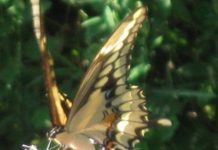by Philip Fry
Darkness has once again spread over our Province. With 16.8 percent of eligible voters claiming a majority government, the illusions we might have had about living in a democracy have sunk into oblivion. But for gardeners at least, light shines in the darkness, and the darkness shall grasp it not.
Before the debacle, I was writing about how to “prep” soil in view of creating a native wildflower garden. Now it is time to think about how light works with plants in your garden site.
A quick reminder: plants capture and transform energy from the sun through the agency of chlorophyll, the pigment which gives leaves their green colour. The pigment absorbs the radiant energy from the sun (predominantly the red and blue areas of the spectrum) and provokes photosynthesis, the reaction in which carbon dioxide is reduced to its two components, oxygen and carbon, and carbohydrates are formed using water and some minerals in solution. This process is the way by which the sun’s energy is harnessed for the use of all living beings, and is therefore the central component of mostly all ecological systems (the exceptions perhaps being newly discovered organisms living near heat vents in ocean depths).
Plants’ leaves have evolved to to maximize their use of sunlight in various habitats. Their diverse sizes, shapes, the structures of their veins, pores, and textures, the way they are arranged on the plant’s stems, and the daily and seasonal timing of their exposure to the light and shade, all collaborate in the task of receiving energy from the sun without exposing the plant to overheating or excessive water loss. There exist internet applications and wildflower handbooks (I prefer the Peterson “A Field Guide to Wildflowers” because the drawings make significant details clear) that are a great help in identifying these factors. In their unique combinations, these factors determine the light preferences of particular plant species. This brings us to the question of the aspect and the light exposure of your garden site.
The aspect of your garden is the main compass direction it faces: in theory, facing south provides maximum sunlight, north the least. In practice, however, obstacles of various kinds – your own or the neighbour’s house, a fence, hedge, or tree – intervene and create shade, modifying the amount of light that falls on the garden site; this is its real exposure. The density and placement of the obstacles produce different degrees and qualities of shade: a well-spaced grove of trees produces dappled shade, which is constantly changing in the degree of light admitted, while a building creates an area of static, deep shade, bordered by areas of transitory degrees of illumination. As the light also varies according to the sun’s angle at various times of the year, the cycle of the seasons needs to be taken into account. In the summer, some areas are exposed to full sunshine, but are in complete shade during the winter. With the summer solstice approaching, this is the best time to observe and mark out the maximum light exposure of your site. Then continue your observations every few weeks until snowfall to determine the increase in the shaded areas.
Exposure, as well as soil quality, are the main determinants of which species of wildflowers will flourish on your site. But there are “in-between” species that do well in transitional exposure zones if all other conditions are satisfactory. A good example is the fragile looking Canada columbine with its nodding red and yellow “lantern” flowers, which thrives in many light gradients as long as the soil is well drained and is gravel-strewn enough to ward off intense competition from more stalwart species. It does best in a slightly nutrient deprived soil. It is just finishing bloom now and will soon be in seed. When collecting seed, never take more than one-tenth of the pods available at the site.
Unless it is in dense architectural shade, the current exposure of your site can be modified over time by adopting the principles of natural plant succession. That is for my next column.
Contact me if you wish at: wildflowerguy@gmail.com.









